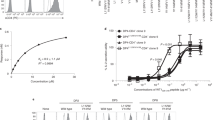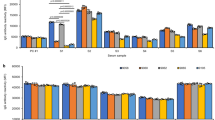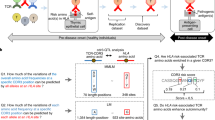Abstract
Genetic, molecular and cellular analyses of the HLA-D region of the major histocompatability complex (MHC) in man have led to the definition of three different products. Two of these, DR and MB (the latter also known as DC (ref. 1) and LB-E (ref. 2)) are defined with serological reagents; the third, known as SB (ref. 3) and PL-3 (ref. 4) is defined with primed lymphocyte typing (PLT) cells5. The classical features attributed to HLA-D region encoded (class II) molecules are that they are cell-surface dimers consisting of a structurally conserved α-chain noncovalently associated with a polymorphic β-chain and that they are found primarily on B lymphocytes, some monocyte populations, endothelial and certain other cells6. Using these criteria a monoclonal antibody,. B7/21, was described as reactive with HLA-DR (ref. 7). We have now re-evaluated B7/21 antibody reactivity using mutant lymphoblastoid cell lines. It appears that this antibody does not react with the molecularly defined D region products described to date but instead, recognizes a class II antigen with distinctive molecular characteristics. We provisionally refer to this antigen as FA.
This is a preview of subscription content, access via your institution
Access options
Subscribe to this journal
Receive 51 print issues and online access
$199.00 per year
only $3.90 per issue
Buy this article
- Purchase on Springer Link
- Instant access to full article PDF
Prices may be subject to local taxes which are calculated during checkout
Similar content being viewed by others
References
Tanigaki, N., Tosi, R., Pressman, D. & Ferrara, G. B. Immunogenetics 10, 151–167 (1980).
Van Leeuwen, A. et al. Histocompatibility Testing (ed. Terasaki, P. F.) 853 (University of Los Angeles, 1980).
Shaw, S., Pollack, M. S., Payne, S. M. & Johnson, A. H. Hum. Immun. 1, 177–185 (1980).
Termijtelen, A., Bradley, B. A. & van Rood, J. J. Tissue Antigens 15, 267–274 (1980).
Sheehey, M. J., Sondel, P. M., Bach, M. L., Wank, R. & Bach, F. H. Science 188, 1308–1310 (1975).
Strominger, J. L. et al. in The Role of the Major Histocompatibility Complex in Immunology (ed. Dorf, M. E.) 115–172 (Garland, New York, 1981).
Royston, I., Omary, M. B. & Trowbridge, I. S. Transplant Proc. 13, 761–766 (1981).
Kavathas, P., Bach, F. H. & DeMars, R. Proc. natn. Acad. Sci. U.S.A. 77, 4251–4255 (1980).
Kavathas, P., DeMars, R. & Bach, F. H. Hum. Immun. 4, 317–324 (1980).
Kavathas, P., DeMars, R., Bach, F. H. & Shaw, S. Nature 293, 747–749 (1981).
DeMars, R., Chang, C. C. & Rudersdorf, R. R. Hum. Immun. (in the press).
Shaw, S., Kavathas, P., Pollack, M. S., Charmot, D. & Mawas, C. Nature 293, 745–746 (1982).
Bach, F. H., Reinsmoen, N. L. & Segall, M. Transplantn Proc. 15, 102–108 (1983).
Shaw, S. et al. J. exp. Med. 156, 731–743 (1982).
DeMars, R. et al. J. Immun. (in the press).
Auffray, C., Kuo, J., DeMars, R. & Strominger, J. L. Nature 304, 174–177 (1983).
Lampson, L. A. & Levy, R. J. Immun. 125, 293–299 (1980).
Shackelford, D. A., Mann, D., van Rood, J. J., Ferrara, G. B. & Strominger, J. L. Proc. natn. Acad. Sci. U.S.A. 78, 4566–4570 (1981).
Shackelford, D. A., Kaufman, J. F., Korman, A. J. & Strominger, J. L. Immun. Rev. 66, 133–187 (1982).
Shackelford, D. A., Lampson, L. A. & Strominger, J. L. J. Immun. 127, 1403–1410 (1981).
deKretser, T. A., Crumpton, M. J., Bodmer, J. G. & Bodmer, W. F. Eur. J. Immun. 12, 214–221 (1982).
Brodsky, F. M., Parham, P. & Bodmer, W. F. Tissue Antigens 16, 30–48 (1980).
Orr, H. T. et al. Nature 293, 454–455 (1982).
Orr, H. T. & DeMars, R. Nature 302, 534–536 (1983).
Nadler, L. M. et al. Nature 290, 591–593 (1981).
Hurley, C. H., Shaw, S., Nadler, L., Schlossman, S. & Capra, J. B. J. exp. Med. 156, 1557–1562 (1982).
Ledbetter, J., Nowinski, R. C. & Emery, S. J. Virol. 22, 65–73 (1977).
Watson, A., Dunlap, B. & Bach, F. H. J. Immun. 127, 38–42 (1981).
Laemmli, U. K. Nature 227, 680–685 (1970).
Bonner, W. M. & Laskey, R. A. Eur. J. Immun. 46, 83–87 (1974).
Author information
Authors and Affiliations
Rights and permissions
About this article
Cite this article
Watson, A., DeMars, R., Trowbridge, I. et al. Detection of a novel human class II HLA antigen. Nature 304, 358–361 (1983). https://doi.org/10.1038/304358a0
Received:
Accepted:
Issue Date:
DOI: https://doi.org/10.1038/304358a0
This article is cited by
-
A single T cell epitope drives the neutralizing anti-drug antibody response to natalizumab in multiple sclerosis patients
Nature Medicine (2019)
-
Mass spectrometry–based identification of MHC-bound peptides for immunopeptidomics
Nature Protocols (2019)
-
The relationship between human leukocyte antigen-DP/DQ gene polymorphisms and the outcomes of HCV infection in a Chinese population
Virology Journal (2017)
-
Defective class II transactivator expression in a B lymphoma cell line
Leukemia (2004)
-
Splicing defect in RFXANK results in a moderate combined immunodeficiency and long-duration clinical course
Immunogenetics (2003)
Comments
By submitting a comment you agree to abide by our Terms and Community Guidelines. If you find something abusive or that does not comply with our terms or guidelines please flag it as inappropriate.



